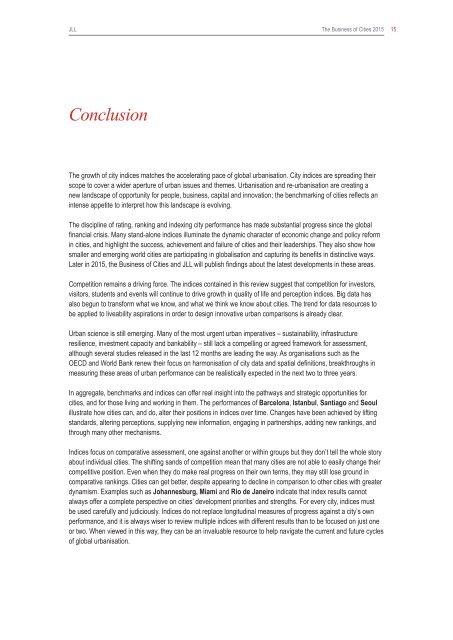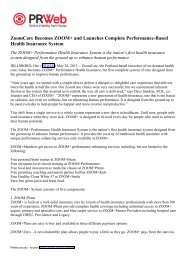The Business of Cities 2015
jll-business-of-cities-report
jll-business-of-cities-report
Create successful ePaper yourself
Turn your PDF publications into a flip-book with our unique Google optimized e-Paper software.
JLL<br />
<strong>The</strong> <strong>Business</strong> <strong>of</strong> <strong>Cities</strong> <strong>2015</strong> 15<br />
Conclusion<br />
<strong>The</strong> growth <strong>of</strong> city indices matches the accelerating pace <strong>of</strong> global urbanisation. City indices are spreading their<br />
scope to cover a wider aperture <strong>of</strong> urban issues and themes. Urbanisation and re-urbanisation are creating a<br />
new landscape <strong>of</strong> opportunity for people, business, capital and innovation; the benchmarking <strong>of</strong> cities reflects an<br />
intense appetite to interpret how this landscape is evolving.<br />
<strong>The</strong> discipline <strong>of</strong> rating, ranking and indexing city performance has made substantial progress since the global<br />
financial crisis. Many stand-alone indices illuminate the dynamic character <strong>of</strong> economic change and policy reform<br />
in cities, and highlight the success, achievement and failure <strong>of</strong> cities and their leaderships. <strong>The</strong>y also show how<br />
smaller and emerging world cities are participating in globalisation and capturing its benefits in distinctive ways.<br />
Later in <strong>2015</strong>, the <strong>Business</strong> <strong>of</strong> <strong>Cities</strong> and JLL will publish findings about the latest developments in these areas.<br />
Competition remains a driving force. <strong>The</strong> indices contained in this review suggest that competition for investors,<br />
visitors, students and events will continue to drive growth in quality <strong>of</strong> life and perception indices. Big data has<br />
also begun to transform what we know, and what we think we know about cities. <strong>The</strong> trend for data resources to<br />
be applied to liveability aspirations in order to design innovative urban comparisons is already clear.<br />
Urban science is still emerging. Many <strong>of</strong> the most urgent urban imperatives – sustainability, infrastructure<br />
resilience, investment capacity and bankability – still lack a compelling or agreed framework for assessment,<br />
although several studies released in the last 12 months are leading the way. As organisations such as the<br />
OECD and World Bank renew their focus on harmonisation <strong>of</strong> city data and spatial definitions, breakthroughs in<br />
measuring these areas <strong>of</strong> urban performance can be realistically expected in the next two to three years.<br />
In aggregate, benchmarks and indices can <strong>of</strong>fer real insight into the pathways and strategic opportunities for<br />
cities, and for those living and working in them. <strong>The</strong> performances <strong>of</strong> Barcelona, Istanbul, Santiago and Seoul<br />
illustrate how cities can, and do, alter their positions in indices over time. Changes have been achieved by lifting<br />
standards, altering perceptions, supplying new information, engaging in partnerships, adding new rankings, and<br />
through many other mechanisms.<br />
Indices focus on comparative assessment, one against another or within groups but they don’t tell the whole story<br />
about individual cities. <strong>The</strong> shifting sands <strong>of</strong> competition mean that many cities are not able to easily change their<br />
competitive position. Even when they do make real progress on their own terms, they may still lose ground in<br />
comparative rankings. <strong>Cities</strong> can get better, despite appearing to decline in comparison to other cities with greater<br />
dynamism. Examples such as Johannesburg, Miami and Rio de Janeiro indicate that index results cannot<br />
always <strong>of</strong>fer a complete perspective on cities’ development priorities and strengths. For every city, indices must<br />
be used carefully and judiciously. Indices do not replace longitudinal measures <strong>of</strong> progress against a city’s own<br />
performance, and it is always wiser to review multiple indices with different results than to be focused on just one<br />
or two. When viewed in this way, they can be an invaluable resource to help navigate the current and future cycles<br />
<strong>of</strong> global urbanisation.








